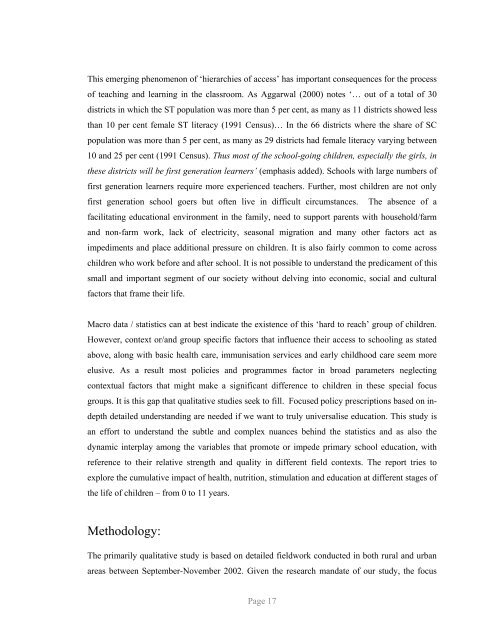Snakes and Ladders - ERU Consultants Pvt. Ltd.
Snakes and Ladders - ERU Consultants Pvt. Ltd.
Snakes and Ladders - ERU Consultants Pvt. Ltd.
You also want an ePaper? Increase the reach of your titles
YUMPU automatically turns print PDFs into web optimized ePapers that Google loves.
This emerging phenomenon of ‘hierarchies of access’ has important consequences for the process<br />
of teaching <strong>and</strong> learning in the classroom. As Aggarwal (2000) notes ‘… out of a total of 30<br />
districts in which the ST population was more than 5 per cent, as many as 11 districts showed less<br />
than 10 per cent female ST literacy (1991 Census)… In the 66 districts where the share of SC<br />
population was more than 5 per cent, as many as 29 districts had female literacy varying between<br />
10 <strong>and</strong> 25 per cent (1991 Census). Thus most of the school-going children, especially the girls, in<br />
these districts will be first generation learners’ (emphasis added). Schools with large numbers of<br />
first generation learners require more experienced teachers. Further, most children are not only<br />
first generation school goers but often live in difficult circumstances. The absence of a<br />
facilitating educational environment in the family, need to support parents with household/farm<br />
<strong>and</strong> non-farm work, lack of electricity, seasonal migration <strong>and</strong> many other factors act as<br />
impediments <strong>and</strong> place additional pressure on children. It is also fairly common to come across<br />
children who work before <strong>and</strong> after school. It is not possible to underst<strong>and</strong> the predicament of this<br />
small <strong>and</strong> important segment of our society without delving into economic, social <strong>and</strong> cultural<br />
factors that frame their life.<br />
Macro data / statistics can at best indicate the existence of this ‘hard to reach’ group of children.<br />
However, context or/<strong>and</strong> group specific factors that influence their access to schooling as stated<br />
above, along with basic health care, immunisation services <strong>and</strong> early childhood care seem more<br />
elusive. As a result most policies <strong>and</strong> programmes factor in broad parameters neglecting<br />
contextual factors that might make a significant difference to children in these special focus<br />
groups. It is this gap that qualitative studies seek to fill. Focused policy prescriptions based on in-<br />
depth detailed underst<strong>and</strong>ing are needed if we want to truly universalise education. This study is<br />
an effort to underst<strong>and</strong> the subtle <strong>and</strong> complex nuances behind the statistics <strong>and</strong> as also the<br />
dynamic interplay among the variables that promote or impede primary school education, with<br />
reference to their relative strength <strong>and</strong> quality in different field contexts. The report tries to<br />
explore the cumulative impact of health, nutrition, stimulation <strong>and</strong> education at different stages of<br />
the life of children – from 0 to 11 years.<br />
Methodology:<br />
The primarily qualitative study is based on detailed fieldwork conducted in both rural <strong>and</strong> urban<br />
areas between September-November 2002. Given the research m<strong>and</strong>ate of our study, the focus<br />
Page 17












